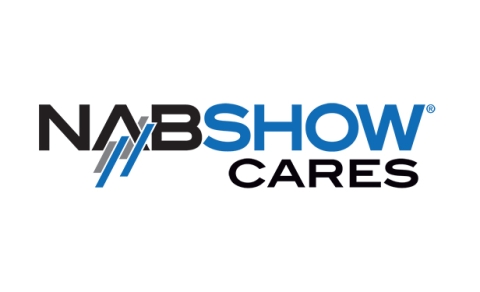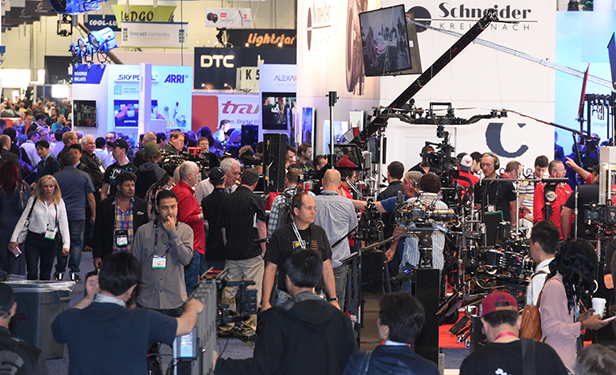NAB Show Eases Exhibitor Pain Points With NAB Show Cares

After two years of extensive research and listening to its exhibitors, the NAB Show has launched a ground-breaking new program designed to support and improve the exhibitor experience by creating a more transparent and sustainable model for its exhibitor services.
Developed in response to exhibitor complaints about the cost and unpredictability of exhibiting expenses, the NAB Show Cares program comprises a series of comprehensive initiatives that address a range of services exhibiting companies described as significant challenges, including material handling, electrical and hanging signs and rigging.
“We understand that participating in events like NAB Show requires a significant investment in time and money, and we are committed to doing all we can to address major pain points to ensure the NAB Show remains the best value in the business,” said Chris Brown, executive vice president of business services for the National Association of Broadcasters.
He continued, “Freeman is a critical strategic partner and we have always enjoyed collaborating with them to explore and address various show needs together. More broadly we have worked with industry consulting firm Tradeshow Logic to build a complete ‘NAB Show Cares’ program that is focused on improving ROI and the exhibitor experience across the board, to include services like electrical, rigging, Internet and even catering.”
Introduced in the Spring of this year, the new program is the result of hundreds of hours of in-depth research, data analysis, exhibitor interviews and service rate re-negotiation carried out by Tradeshow Logic, which helped NAB get to the root of the issues exhibitors were experiencing and then find solutions to create significant, transformative changes.
“We started our analysis, data analytics and research work in the fall of 2016 and introduced NAB Show Cares in March 2018 to respond to exhibitor inquiries and ensure adoption of all the initiatives that are being launched for NAB 2019,” explained BJ Enright, president and CEO of Tradeshow Logic.
She continued, “NAB wanted to get to the root of some of these pain points, but they wanted to do that in a truly significant way that would get after some of those things we’ve all come to accept as ‘industry standards.’ They brought us on to help them identify ways we could analyze all of their services, so our scope of work involved analyzing all of NAB’s exhibitor ordering data for a little over 30 show services, ranging from housing to material handling to Internet to floral. We analyzed the data as well as did outreach into the exhibitor appointed contractor community and directly to the exhibitors to collect data and ask what exhibitors were spending outside of the official contractors.”
The event solutions company even went so far as to send a representative to the International Broadcasting Convention (IBC) in Amsterdam, a broadcasting technology trade show many NAB exhibitors participate in, to learn what appealed to exhibitors, suppliers and contractors about doing business at IBC and how that could be applied at NAB, Enright added.
Eight months of research and interviews later, the Tradeshow Logic team then turned its attention to identifying and prioritizing the services that exhibitors most wanted addressed in order of importance, as well as shaking up the Show’s RFP process by putting every service out to bid separately.
“We said, ‘this is how we want to pay and this is how we want to play,’ so we defined the rules of the engagement (with the RFP respondents),” Enright explained.
She continued, “We said, ‘here’s our target rates and you can go higher or lower, or if you have an idea or a solution for how to do this differently we’ll consider it, but we’re going to define the rules of the game and the rate.’ So we changed what I call the business rules, how those things get charged as well as the operational rules for how the procedure works. We sent (the RFPs) out and it was an amazing process. A lot of the contractors that bid were very creative in terms of being willing to think about new and different augmentations to what we submitted, so they were very true to the process.”
In the end, NAB ended up sticking with Freeman, its event services provider for the last nine years, which rose to the occasion by collaborating with NAB and Tradeshow Logic on all of the solutions, rates and implementation, Enright added.
“We always look for innovative ways to support our customers given their needs and requirements and we were happy to support NAB as they looked for new ways to structure their show, one which is very important to the economy and the market it serves,” said Ellen Zeidler, senior vice president of Global Communications for Freeman.

Launched just time for the 2019 booth space sales held onsite at the 2018 NAB Show last April, the Unlimited Material Handling initiative reduces fees for moving freight from dock to booth and back via a fixed rate per square foot that covers any or all items an exhibitor brings into the show regardless of quantity, weight or volume.
Instead of receiving an invoice for material handling after the show, exhibitors simply pay for the service up front when they purchase their booth space.
While some exhibitors who previously didn’t use the service will now pay a minimal fee, the initiative has resulted in an overall average savings of nearly 40 percent and up for some of the larger exhibiting companies, according to Enright.
“NAB has been communicating to exhibitors that now they have this great service that allows them to do whatever they need to do – they’re not inhibited by having to think about what they’re bringing to the show,” Enright explained.
She continued, “Yes, they still have to ship it in and pay for their shipping but once it gets to show site, from the dock to the booth their labor and that expense is covered. Now they can think about how to best attract attendees to their booth rather than spending all their time thinking about how they’re going to avoid paying for it.”
As an eight-year exhibitor and four-year member of NAB’s exhibitor advisory committee, Christy Ricketts, vice president of operations and marketing for Contemporary Research, believes the initiative poses a great opportunity for exhibitors.
“This program is a welcome change because it encourages all exhibitors to bring more items into the show to enhance their booth space,” Ricketts said.
She continued, “We represent a smaller booth, so the pricing is not as great a savings for us as it is for some companies but I like that we pay for the services before the show. It’s one less thing to pay for in April, when additional show expenses such as food, travel and hotel are being expensed. Being a smaller booth and not having to worry about bringing in our own items is great – it will be much easier to just ship the items to the venue and know they’ll be waiting for me in my booth.”
The next service exhibitors had expressed the most frustration with was electrical pricing and what exhibitors called “hidden costs,” aka, charges for extension cords, materials and labor. Not only did exhibitors find these expenses difficult to budget for but also to review and audit on post-show invoices.
In response, NAB Show Cares unveiled No Surprise Electrical Outlet Pricing, which offers the outlet, materials and floor work labor for one price.
“Because some of the smaller exhibitors didn’t save with the material handling model, we’re offering a really low rate for those in a 10x40 booth or below – they get a rate 17 and a half percent less than what they paid last year and it includes the materials and floor work,” Enright explained.
She added, “With everything we do we’re trying to think about the entire exhibitor community and (what) will help everybody as a whole to exhibit better.”
With hanging and rigging playing such a big role at the Show due to the nature of the products and services exhibiting companies display, a big pain point for exhibitors was not so much the expense of rigging crews to hang truss and lights but more the added costs of rigging supplies.
Launched this month, Inclusive Rigging Pricingaddresses this problem by including rigging supplies with the rigging crew rate, which will now make it easier for exhibitors to review invoices and budget for such a major show expense.
“We started with the services that exhibitors put in priority order in terms of what they were spending and what they wanted to be addressed,” Enright said. “We take each of the priorities and follow the same process of creating solutions and promoting them, and now we’re in the ongoing process of implementing those solutions.”
Behind the scenes, the NAB Show Cares team – a combination of Tradeshow Logic and NAB team members – are continuing to focus on elevating the level of exhibitor care.
“What we’re still doing now is educating and communicating the new solutions to the exhibitors,” Enright said. “It’s going to take time for exhibitors to see that they’re really achieving the savings and then it’s important for NAB to help them also figure out how to drive the value side of that equation.”
She added, “NAB Show Cares is there to help them…especially the mid-sized and smaller exhibitors because they have the most potential to grow and need the most help.”
According to Ricketts, NAB Show Cares has been doing a great job communicating the service changes to exhibitors as well as supporting them in the process.
“We had a large number of exhibitors who were very concerned about rising show costs really getting out of control (and) the NAB Show listened and committed hundreds of hours of research into discovering what the root of the problem was and coming up with solutions on how to fix it,” Ricketts said.
She continued, “We talked about this issue for at least two years in our EAC meetings and were very involved with coming up with this new structure. NAB Show Cares was created from all the questions we had about how this change would impact each exhibitor. We wanted to address the concerns and make sure we highlighted the benefits – transparency was extremely important to everyone!”
Could the NAB Show Cares model mark the beginning of an industry-wide trend? While such a program may seem simple and straightforward on the surface, it may not necessarily be the right fit for every trade show, Enright emphasized.
“I hope that exhibitors and show organizers really look at, talk about and figure out what’s right for their show and what needs to be changed (and) while what we’re doing for NAB may not work for every show, there are solutions that can be developed and customized for every event,” Enright said.
She continued, “NAB wanted to know what their exhibitors thought and they listened to them and if there’s a lesson in this, that should be it. If there’s a trend to come out of NAB Show Cares it should be that we as an industry recognize that it’s that exhibitor and attendee relationship that keeps us all working and that the exhibitor needs to be getting their ROI out of the events that we produce.”
Don’t miss any event news! Sign up for any (or all) of our e-newsletters HERE & engage with us on Twitter, Facebook, LinkedIn & Instagram!


Add new comment